The Japanese Wave: Cultural Impact on Watersports
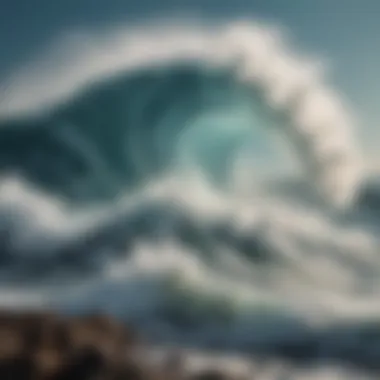
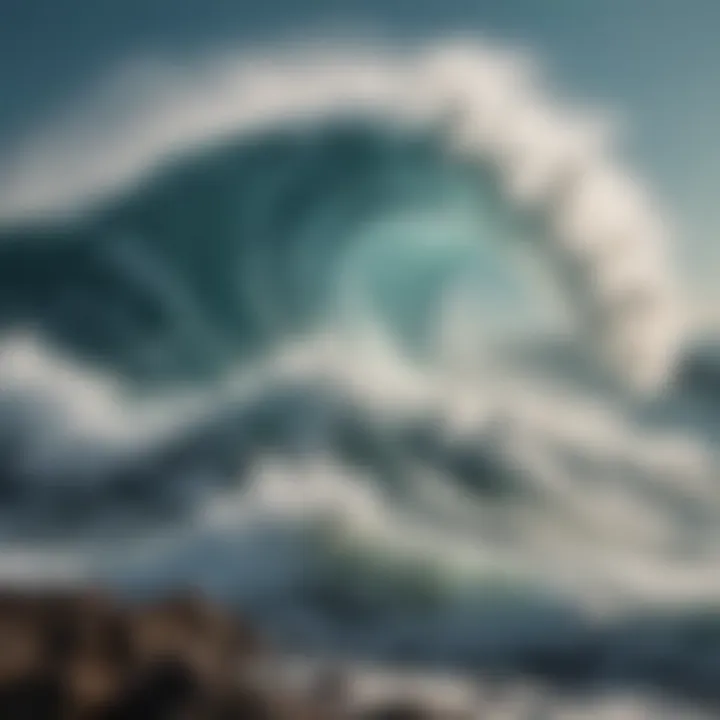
Intro
The aquatic world of Japan is deeply intertwined with the essence of its waves, where every crest and trough carries stories from the past. Understanding these waves does not only involve catching them on a surfboard or navigating them on a canoe; it also requires diving into the cultural currents that shape Japan's relationship with water.
From ancient art forms to modern sports, the influence of waves permeates numerous aspects of Japanese culture. Wave motifs have become symbols of strength, resilience, and beauty, etched in the minds of both locals and visitors alike. They offer insights into not only the physical realm of watersports but also the underlying philosophies that guide these practices.
Techniques and Skills
Delving into the significance of waves in watersports, it becomes clear that mastering the techniques tied to these natural phenomena is paramount.
Speaking of skills, the water invites enthusiasts ranging from novices to seasoned pros—all with their unique experiences shaped by waves' rhythm.
Essential Techniques for Beginners
Embarking on the journey as a futuresport lover? It’s essential to grasp the fundamental techniques that lay the groundwork for a lifelong connection with water activities.
- Understanding Wave Dynamics: Before you hit the waters, familiarize yourself with how waves form and break. This knowledge helps in predicting where to position yourself.
- Paddling: For those starting with kayaking or stand-up paddling, mastering the paddling technique is vital. Efficient strokes allow for easier navigation, especially when confronting challenging waves.
- Balance: In surfing or any board sport, maintaining balance is key. Beginners should practice on calm water before transitioning to bigger waves.
Remember, safety comes first. Always wear a life jacket until you are confident in your skills.
Advanced Skills for Experienced Watersport Enthusiasts
For those who have navigated the waters for a while, enhancing your skills involves fine-tuning techniques that may lead to thrilling experiences.
- Wave Selection: Skilled surfers learn to read waves and choose the right one to ride. Timing can mean the difference between an exhilarating ride and a wipeout.
- Carving and Turns: Once you’re comfortable on a board, brush up on your carving techniques. These moves not only boost performance but also help in navigating through challenging wave patterns.
- Safety and Rescue Techniques: Veteran watersport enthusiasts must also be prepared for emergencies. Learning self-rescue techniques or how to assist others in danger can save lives.
"Knowledge of waves is like harnessing the wind; both require respect and skill to navigate successfully."
Equipment and Gear
Gearing up appropriately can make or break your experience with watersports. Selecting the right equipment tailored to the specific kind of activity is essential too.
Must-Have Gear for Each Watersport
- Surfing: A well-fitted surfboard, leash, and a wetsuit for warmth are basic essentials.
- Kayaking: Apart from the kayak itself, you’ll need a personal flotation device, paddle, and possibly a spray skirt for sit-in kayaks.
- Stand-Up Paddleboarding: An inflatable or rigid SUP board, a paddle, and a life jacket complete your gear.
Tips for Selecting the Right Equipment
When choosing equipment, it’s important to consider the following:
- Sizing: Equipment should fit your body size and skill level to ensure optimal performance.
- Material: Whether it’s a surfboard or a kayak, materials can dictate the weight, durability, and price range.
- Budget: Your financial plan should guide selections without compromising safety and quality.
If you're interested in diving deeper into the cultural impact of Japanese waves in watersports, consider exploring resources such as Wikipedia, or joining discussions on Reddit to connect with other enthusiasts.
In summary, waves serve as the heartbeat of Japanese watersports, reflecting a rich history and cultural significance. Whether a beginner or a seasoned enthusiast, understanding the depth of these elements fosters not only skill development but also a rich appreciation for the aquatic world.
Preface to the Japanese Wave
The concept of the Japanese wave extends far beyond mere water movements in the ocean. It encapsulates a tapestry of cultural significance, aesthetic representation, and socio-environmental dynamics that shape various facets of life in Japan. This introduction establishes the foundational elements that highlight why the Japanese wave deserves attention, especially within the context of this article.
From ancient times to the present day, waves have inherently influenced various expressions of Japanese art and literature. Artists like Katsushika Hokusai have utilized waves not just as artistic motifs but as emblems of cultural identity. The aesthetic charm of waves invites observers to delve deeper into their symbolic meanings—the ebb and flow of life, resilience against adversity, and the perpetual motion of both water and time. It signifies how intertwined nature and culture are in the Japanese psyche.
Moreover, the resonance of waves in modern sporting contexts plays a significant role in shaping the identity of watersports in Japan. As the popularity of surfing, paddleboarding, and other aquatic activities surges, understanding the cultural context of these waves becomes essential. Surf spots such as Shirahama and Chiba are more than just locations; they're symbols of a cultural revival that marries tradition with contemporary practice.
Key considerations around this exploration include:
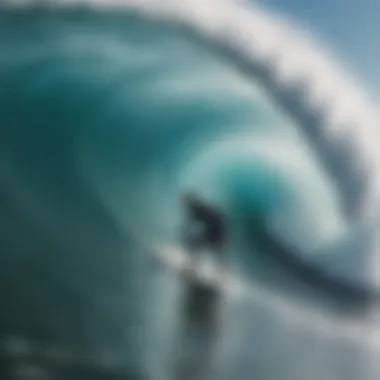
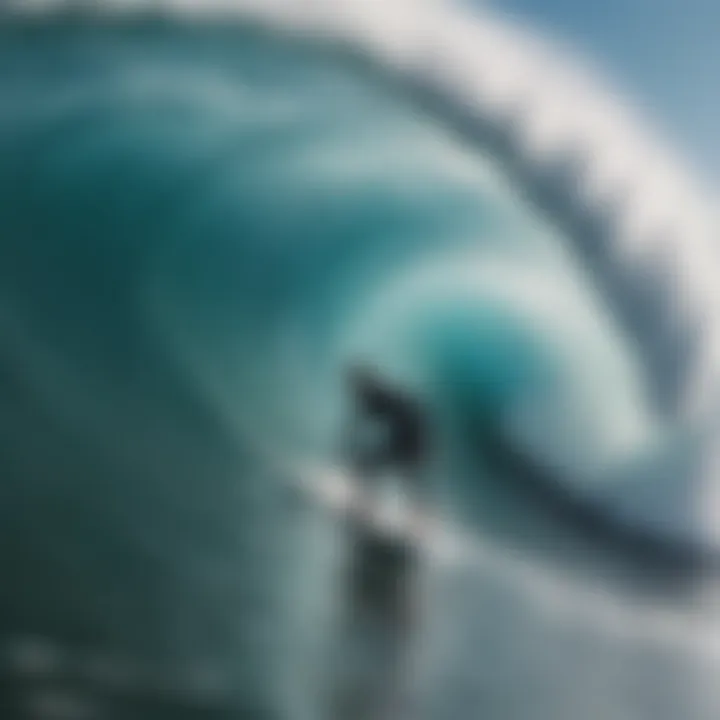
- Cultural Relevance: Understanding how waves connect to Japanese traditions enriches an appreciation for the sport.
- Artistic Influence: Recognizing the artistic expressions inspired by waves can inspire today's artists and athletes alike.
- Environmental Awareness: In an age of climate change, the role waves play in ecological concerns can't be overstated. Comprehensive awareness of wave behavior fosters safety and sustainability.
The investigation into the Japanese wave opens up a dialogue, revealing layers of meaning that resonate with sports enthusiasts, adventure seekers, and marketers in the watersports industry. As we dive deeper into the historical contexts, artistic representations, and the intricate relationship between waves and contemporary practices, we invite readers to join us on this enlightening journey.
"The wave is a force of nature; it teaches us about the balance of life and the strength to overcome obstacles."
By appreciating the multifaceted nature of the Japanese wave, we lay the groundwork for understanding its vast impact on watersports today.
Historical Context of Waves in Japanese Culture
Waves have always held a special place in the tapestry of Japanese culture, intertwining with nature, art, and spirituality in ways that go beyond mere aesthetics. They are not just physical phenomena; they embody a sense of beauty and respect for the turbulent yet mesmerizing forces of nature. Understanding this context is crucial not only for appreciating the art forms that feature waves but also for grasping their role in contemporary watersports.
The depiction of waves provides insight into how the Japanese perceive their environment—a blend of reverence and awareness. It highlights the deep connection between humanity and nature, promoting a mindset that values harmony and balance. This historical context fosters an appreciation of how those waters not only shaped the art but, by extension, influenced the development of various water-related activities over time.
Influence of Nature on Japanese Artistic Expression
Nature remains a cornerstone of Japanese artistic expression, providing an endless source of inspiration. Waves, in particular, resonate deeply in the psyche of the Japanese people. For artists, capturing the ebb and flow signifies more than just a visual representation; it's about translating feelings into visuals. Nature here is seen as dynamic, not static, forcing artists to stay in tune with its rhythms.
The Japanese concept of mono no aware, or an empathy towards things, can often be seen in how waves are represented. This connection transforms artistic endeavors into reflections of life itself, embodying themes of impermanence and change—concepts that naturally align with the ever-moving waves of the ocean.
Traditional Japanese Art: Waves Depicted
Hokusai's The Great Wave
Hokusai's The Great Wave off Kanagawa offers a striking example of how waves transcend mere representation to evoke profound emotions and ideas. This woodblock print, not only a standout in traditional Japanese art but also a meaningful dialogue about nature's might, carries immense cultural weight that reaches far beyond the borders of Japan. The way Hokusai contrasts the towering wave with the calm Mount Fuji paints a picture of duality: serenity against ferocity and humans against nature.
One of its key characteristics is the blend of intricacy and simplicity. It’s approachable yet layered—encouraging viewers to look deeper while luring them in visually. This profound visual juxtaposition makes it a compelling choice for this article, as it encapsulates the awe-inducing nature of waves while promoting the conversation around watersports. The scene itself, with its swirling energy and determination, serves as a call to respect the ocean's force while drawing closer to its beauty.
In a broader context, the print also serves as a reminder of the history of Japan's relationship with the sea, a bond that spans centuries.
Symbolism of the Wave in Ukiyo-e
Beyond Hokusai, the symbolism of waves in the ukiyo-e genre speaks volumes about the intersection of art and human experience. Waves in ukiyo-e represent not just physical realities but also emotional states and cultural milestones. They hint at unpredictability and adventure, echoing the sentiments of those who both feared and revered the sea.
The waves can signify obstacles but also opportunities for growth and change, making them relevant in both historical and modern contexts. Their undulating forms allow artists to fuse energy and fluidity in a way that resonates with many viewers. This aspect makes discussions around the symbolism of waves particularly beneficial for our exploration of watersports: they inspire adventure, caution, and connection.
Through understanding ukiyo-e and its representation of waves, modern practitioners of watersports can carry forward the cultural lessons embedded in these artworks while paying homage to their roots.
The Wave in Japanese Literature and Lore
The portrayal of waves in Japanese literature is a testament to how deeply intertwined nature is with the cultural and spiritual fabric of the nation. Waves symbolize not just turmoil but also resilience, reflecting the dual nature of existence; calmness often precedes chaos. This exploration of waves showcases how they condition folklore, mythological narratives, and even contemporary pop culture, providing a rich narrative that resonates with different generations.
Folklore and Mythological Instances
In Japanese folklore, waves are often woven into the very fabric of mythological tales. The sea itself has long been a source of inspiration, giving rise to legends of sea deities and creatures. One prominent figure is the dragon god, Ryujin, who governs the ocean's tides and waves. His representation embodies the might and unpredictable nature of water; both revered and feared.
Another notable mythos is the Tale of Urashima Taro, which speaks of the fisherman who rescues a turtle and is taken to the Dragon Palace beneath the sea. The narrative uses waves to signify the barriers between the known world and hidden realms, emphasizing transformation and the passage of time.
These tales often hint at nature’s volatility. Waves act as a threshold—an entryway into the vast unknown, symbolizing both our ambitions and fears. This thematic exploration serves as mental food for thought, encouraging readers to reflect on their relationships with nature.
Contemporary References in Japanese Media
In modern Japanese media, references to waves continue to be prevalent, permeating literature, film, and anime. For instance, Wave in the Hollow, a contemporary novel explores the impact of environmental changes on coastal communities. Through its narrative lens, waves act as metaphors for change—highlighting both ecological concerns and human resilience.
Anime series often depict characters surfing, surrounded by dynamic waves that embody their struggles and victories. A popular example is the anime KonoSuba, where energetic wave scenes signify the challenges that the protagonist faces on his adventurous journey.
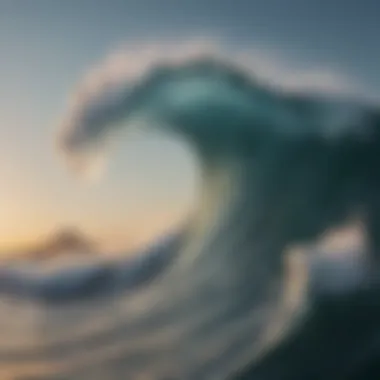
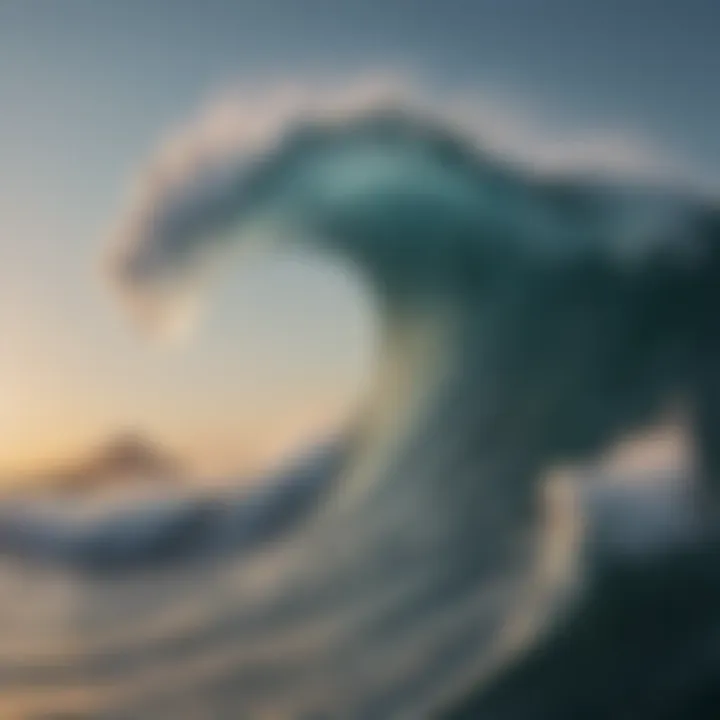
Moreover, popular manga, such as One Piece, showcases ocean waves as both obstacles and opportunities for exploration. Here, waves represent freedom and the thrill of adventure, underscoring how deeply ingrained the sea and its movements are into the collective consciousness of the Japanese people.
"The waves are not just natural occurrences; they tell stories of our existence, both in the past and in the present, bridging tradition and modernity."
Through these diverse mediums, the wave motif encapsulates a range of human emotions and experiences, resonating with sports enthusiasts and storytellers alike. Each narrative thread connects back to the broader cultural significance of waves, giving readers an appreciation for both the tranquil and tumultuous aspects of life. This deep connection emphasizes the waves’ role not only as a physical phenomenon but also as a bridging concept across various forms of storytelling.
Understanding the Physics of Japanese Waves
Understanding the physics involved in Japanese waves gives insight into how these dynamic forces, shaped by geography, climate, and tidal mechanics, impact the aquatic sports landscape. This section is crucial for both amateurs and seasoned professionals who wish to comprehend the essential interactions between the ocean and their sporting ventures. Knowledge of wave behavior not only enhances performance but also ensures safety, making an understanding of physics fundamental to enjoying watersports like surfing, windsurfing, and paddleboarding in Japan’s coastal regions.
Types of Waves Found in Japanese Waters
Japanese coastal waters showcase a variety of wave types, two notable categories being swells and tides. These waves govern the conditions surfers and other watersport enthusiasts face daily.
Swells and Tides
Swells can be understood as longer waves that travel over great distances, primarily generated by winds over the ocean's surface. A defining characteristic of swells is their ability to maintain energy over distances, which often leads to desirable wave conditions for surfers.
- Key Characteristics: The most remarkable feature of swells is their consistency; they can produce reliable surf conditions, crucial for those seeking the perfect ride.
- Benefits: For surfers, swells often lead to excellent, clean waves that can be surfed for extended periods. This stability makes them a popular choice for events.
- Disadvantages: However, understanding swells requires knowledge of their formation and local wind patterns, leading to a steep learning curve for newcomers.
Seasonal Variations in Wave Patterns
The seasonal shifts in Japan's oceanic climate result in distinct wave patterns, influencing watersports throughout the year. Each season brings different characteristics and challenges.
- Key Characteristics: In winter, for example, larger swells can be observed, while summer sees gentler, more playful waves which are preferable for beginners.
- Benefits: Seasonal variations provide a feast of opportunities for different skill levels. Experienced surfers may enjoy the challenge of more powerful waves in winter, whereas novices can practice in gentler summer conditions.
- Disadvantages: These variations can add complexity to planning surf trips, as conditions can change rapidly.
Impact on Watersport Environments
The interplay of wave types and seasonal variations has profound implications on watersport environments in Japan. Where swells promote robust surfing competitions, seasonal variations allow for a broader range of activities, ensuring that every enthusiast can find something to enjoy at their respective skill level.
The dynamic nature of these waters encourages conservation efforts and environmental awareness, vital for sustaining the quality of surfing and other activities. By understanding how waves behave, from the calmest days to the fiercest storms, watersport practitioners can make informed decisions that ensure their safety and the health of their local environments.
"Knowledge is power, especially in the water; understanding wave dynamics can elevate your surf game to impressive heights."
Japanese Wave Techniques in Surfing
Surfing in Japan isn't merely a sport; it's a communion with nature that resonates deep within the cultural psyche. The techniques honed over generations speak volumes of the respect for the ocean and its waves, which are often regarded as living entities. Understanding these unique methods reveals not just skill but a profound connection that many surfers share with their environment.
Wave Riding Strategies
To ride a wave effectively, one must grasp the subtleties of its behavior. Japanese surfers, drawing from the knowledge passed down through time, utilize various strategies that mirror the cycles of nature.
- Reading Wave Patterns: Before even paddling out, observing the water conditions is critical. Experienced surfers often stand on the beach, scanning the horizon for swells, rip currents, and locals’ moves, giving them an edge when they finally hit the surf.
- Take Off Techniques: Timing is everything in wave riding. The infamous “take off” in Japan often requires swift action as waves can break unexpectedly. Use a low center of gravity to duck dive, maintaining momentum while avoiding drops that can lead to wipeouts.
- Lineup Positioning: Knowing where to position oneself in the lineup is vital. Local surfers often jaw about their "secret spots", places where the waves are just right, depending on the season. This precision, coupled with knowledge of reef formations, allows for optimal wave selection.
- Flow and Maneuverability: Once riding a wave, maintaining flow is essential. Japanese styles emphasize fluidity, using body movements to maneuver gracefully rather than relying solely on raw power. Movements often follow the wave's rhythm, enhancing not just control but also the aesthetic of the ride itself.
Cultural Perspectives on Surfing in Japan
Surfing in Japan has evolved, intertwining with both modern sports culture and traditional values. The perception of surfing isn’t simply about catching waves; it reflects broader social and cultural themes.
- Community and Belonging: Surfing is often seen as a communal activity. From beach clean-ups to competitive events, surfers in Japan forge deep connections with each other and foster a sense of responsibility towards their local environments. These actions resonate with the Japanese principle of community and sustainability.
- Balance of Tradition and Modernity: While surfing seems modern, many practices draw from ancient coastal traditions. For instance, rituals to honor the ocean are not uncommon, where surfers express gratitude through offerings, blending surfing with spiritual respect towards the sea.
- Youth Culture and Identity: For the younger generation, surfing embodies a sense of freedom and exploration, often seen as a counterculture to the traditional academic focuses prevalent in Japan. It nurtures individuality while still adhering to the underlying thread of respect for nature.
"Surfing in Japan is like a dance with the ocean; it demands respect and rewards with connection."
The Interplay Between Traditional Practices and Modern Watersports
The connection between traditional practices and modern watersports in Japan is not merely a passing interest; it’s a deep-rooted relationship that defines aquatic activities for many. Waves have always been both a source of inspiration and challenge, and how they are interpreted through the lens of tradition can inform contemporary approaches to watersports. Embracing elements of history within modern practices can enhance skill, promote respect for nature, and foster community.
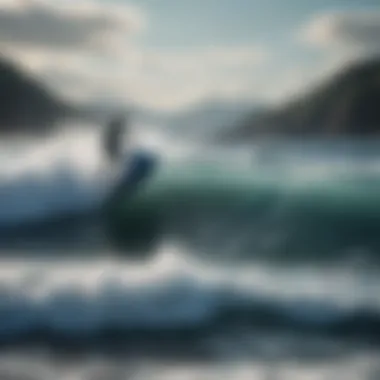
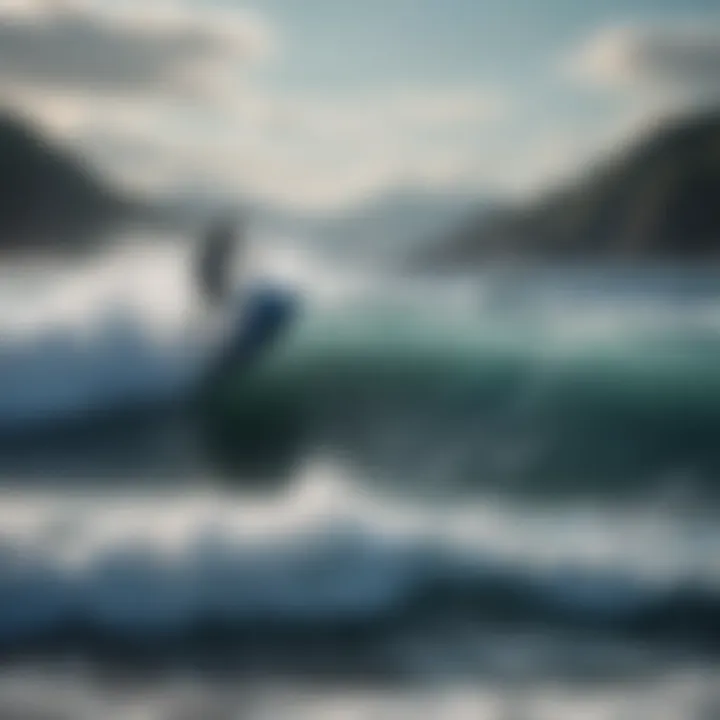
Integration of Traditional Values into Watersport Activities
When we talk about integrating traditional values into modern watersport activities, it becomes apparent that Japan’s cultural heritage offers more than just a backdrop; it provides a framework for engagement. For instance, the principles of harmony and respect that stem from Shinto beliefs manifest in the way surfers interact with the ocean. Surfers are often taught to approach the waves as if they were revered spirits, deserving of respect.
Here are a few ways traditional values shape today's watersports:
- Mindfulness: Practicing awareness in the water, often linked to Zen Buddhism, encourages surfers to be present and connected to their surroundings.
- Community Engagement: Activities like traditional fishing or ancient surfing methods emphasize group harmony, inspiring modern surfers to cultivate a sense of belonging.
- Sustainability: Many traditional practices revolve around environmental respect, making eco-conscious actions more prevalent among today’s watersport enthusiasts.
"To understand the ocean is to understand our place within it, guided by traditions that never fully leave us."
These values align well with prevalent global trends that highlight sustainability and community, ensuring that as watersport aficionados develop their skills, they also honor the cultural heritage that paved the way.
Impact on Global Watersports Culture
The influence of Japanese waves on the global watersports scene cannot be overlooked. As surfing and other water activities gain momentum worldwide, Japanese techniques, styles, and philosophies are being adopted and adapted by diverse groups. The aesthetic appeal of Japanese artistry, especially evident in the portrayal of waves, continues to attract attention beyond Japan.
Some notable impacts include:
- Surfers Abroad: Many surfers drawn to Japanese waves not only learn the sport but also acquire the mindset that surrounds it. This cross-cultural exchange invigorates local surfing communities wherever they go.
- Design Innovations: Reflecting on the natural elegance found in Japanese wave designs, manufacturers are being influenced to craft gear that promotes both performance and aesthetic beauty. Boards and wetsuits that incorporate elements from traditional art find a home in international markets.
- Cultural Festivals: Various global events celebrate not only surfing but also related cultural practices, integrating traditional Japanese elements into competitions and gatherings. This fosters a greater appreciation for the duality of sport and tradition.
In essence, as modern watersports evolve, they do so in a manner that acknowledges and respects the vibrant tapestry of Japanese culture, ensuring that the essence of tradition flows seamlessly with contemporary practices.
Safety and Environmental Awareness in Japanese Waters
In the context of Japanese waters, safety and environmental awareness represent critical elements for both watersport participants and the ecosystems they engage with. As the popularity of watersports continues to rise, so does the need for responsible practices that protect individuals and the coastal environments they inhabit. With Japan’s unique and varied marine landscapes—from the clear waters of Okinawa to the surf-friendly coasts of Chiba—understanding how to navigate these waters safely is paramount.
One cannot overlook the interplay between human activities and natural systems. Waves may present exhilarating opportunities for surfing, kayaking, and other aquatic sports, but they also pose risks. Recognizing these dangers, such as rip currents, changing tides, and sudden weather patterns, is essential. Practicing safety not only promotes a positive experience for enthusiasts but also helps in safeguarding lives.
Understanding Wave Behavior for Safety
Understanding how waves behave is half the battle for anyone engaging in watersports. Comprehending wave types, such as swells and chop, can greatly influence decisions that affect both safety and enjoyment. For instance:
- Swells result from distant storms and can lead to powerful waves that are often favored for surfing.
- Choppy water, caused by wind, can create unpredictable conditions that may be less suitable for novice water enthusiasts.
Furthermore, awareness of local conditions—like underwater topography and weather patterns—allows for an educated approach to activities in the water. Observing how the waves interact with the coastline can be insightful. Fishermen often share tips with surfers about these interactions, creating a richer tapestry of local knowledge that newcomers should be eager to learn. Notably, many surf schools in Japan integrate safety training regarding wave behavior into their curricula, emphasizing that understanding these elements goes beyond merely catching the next wave.
"Knowledge is safety, and with knowledge, we can ride the waves in harmony with nature."
Conservation Efforts in Japanese Waters
With the rise of popularity in watersports comes a heightened responsibility towards environmental stewardship. Japan has recognized the necessity of protecting its beautiful coastlines and marine ecosystems from the adverse effects of human activity. Conservation efforts are varied and multifaceted, focusing on:
- Marine Protected Areas (MPAs) that restrict damaging activities, allowing marine life to thrive. These areas not only conserve biodiversity but also enhance the overall quality of watersport experiences by promoting healthy ecosystems.
- Public awareness campaigns aimed at educating both locals and tourists about pollution, the importance of respecting marine life, and sustainable practices. This includes initiatives to reduce plastic usage and responsible waste disposal.
In addition, many clubs and organizations routinely organize beach clean-ups, fostering a strong community spirit among watersport enthusiasts. These initiatives not only create cleaner environments but also cultivate a conservation mindset among participants, encouraging them to think deeply about their direct impact on the water.
As sports enthusiasts, understanding these elements is crucial—not only for enjoyment but for ensuring that such activities can continue for future generations to enjoy. Protecting Japan's coastline and oceans ensures that waves remain a source of beauty and adventure.
Ending: The Lasting Impact of the Japanese Wave
As we wrap up our exploration into the complex world of Japanese waves, it becomes clear that their significance transcends mere aesthetics or sports. The cultural impact of these natural phenomena cannot be overstated, as they are interwoven through various aspects of Japanese life, from ancient art forms to modern sports practices.
The wave, as a symbol, captures the essence of impermanence and change—concepts that are deeply rooted in Japanese philosophy. This depth of meaning allows enthusiasts and practitioners alike to not only appreciate the physical aspects of surfing or other watersports but to also embrace the spiritual and cultural contexts surrounding these experiences.
Japanese waves teach us vital lessons about respect for nature. Surfers and watersport enthusiasts are reminded of their responsibility to preserve the oceanic environment. This is particularly relevant in today’s context where environmental issues are increasingly pressing. Therefore, the call for conservation efforts, as highlighted in previous sections, resonates strongly through the echo of every wave that crashes onto the shore.
Moreover, the integration of traditional practices into modern watersports is empowering. It provides a means for cultural continuity while adapting to contemporary needs. For instance, the teaching methodologies utilized by experienced instructors often reflect the ancient knowledge, underscoring the importance of maintaining cultural heritage amidst the tide of globalization.
"The wave is not just a swell of water; it is a dynamic extension of a culture that embraces nature, reverence, and change."
Overall, the lasting impact of the Japanese wave is felt through its artistic representations, philosophical implications, and the way it fosters a sense of community among those who engage with it. As both a source of inspiration and a place of recreation, the waves of Japan continue to thrive as a critical element in the broader discourse of cultural significance and environmental stewardship.







